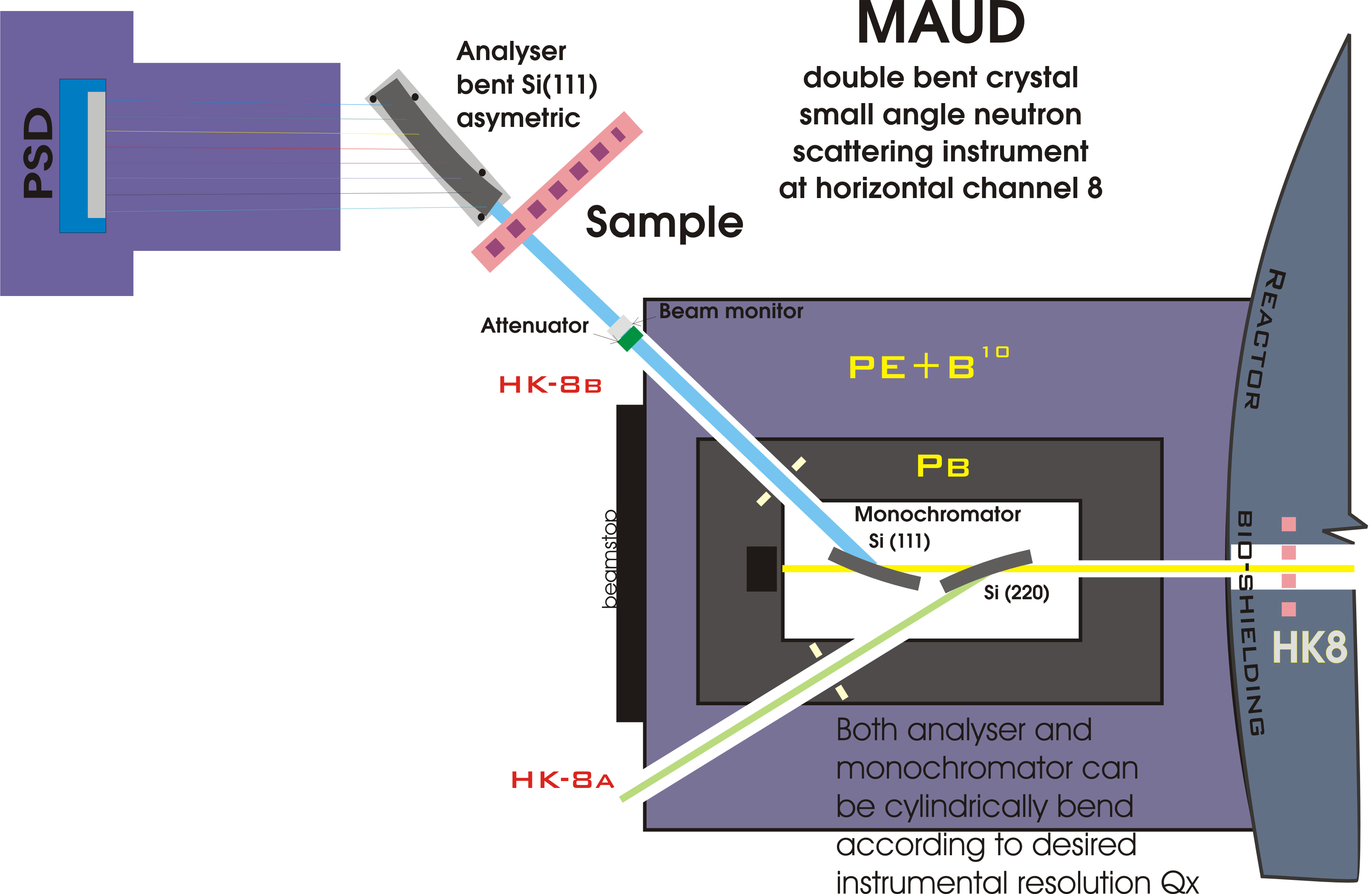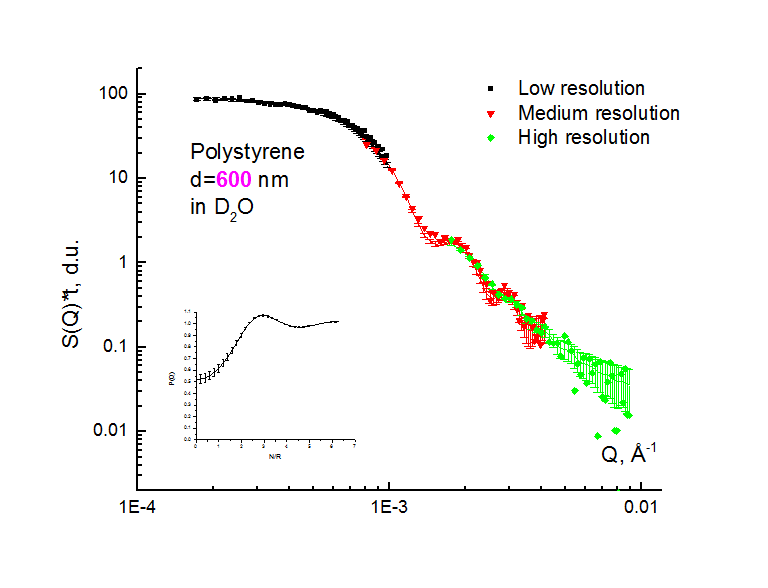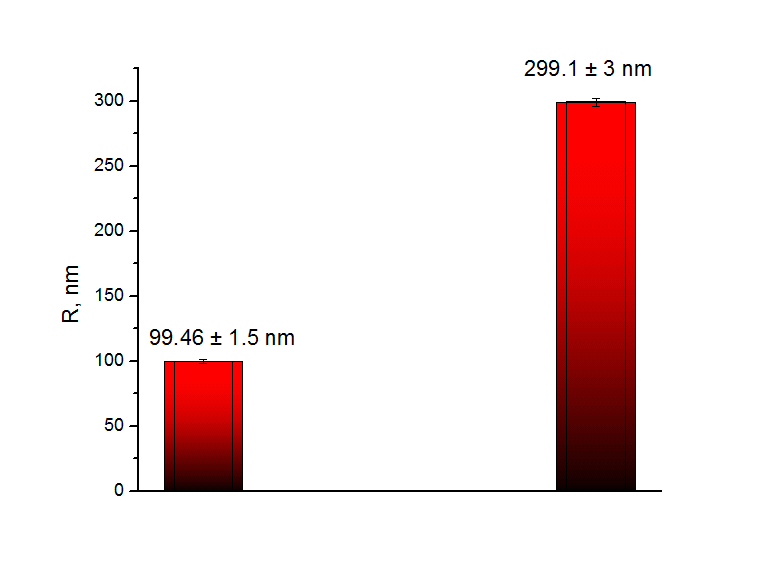MAUD description
The double-crystal diffractometer MAUD (formerly DN-2) is designed for the measurements of neutron small-angle scattering in the high Q-resolution mode. In contrast to conventional double-crystal arrangements (step-by-step angular scanning), a fully asymmetric diffraction geometry on the elastically bent Si analyzer is employed to transfer the angular distribution of the scattered neutrons to the spatial distribution at position sensitive detector (PSD) which enables equisition of the whole scattering curve by a one-/two-dimensional PSD. It reduces the exposure time per sample typically to 0.5-5 hours (depending on the particular Q-resolution and sample cross-section).
MAUD is suitable for investigation of inhomogeneities in the size range from 20-50 nm up to several micrometres and is thus complementary to conventional pin-hole SANS facilities (see e.g. SANS I at SINQ) and Bonse-Hart or focusing USANS (e.g. KWS-3 at MLZ).
Applications
Investigation of structural or compositional inhomogeneities in materials in the size range from 20-50 nm to several μm, mainly (link to publications as examples):
- porous materials (porous glasses, plasma-sprayed ceramics, hydrated cement pastes, porous metallic membranes)
- large precipitates in alloys (gamma prime phase in superalloys, NiTi-alloys, TiAl-alloys, etc.)
- microstructure of porosity in BaTiO3 ceramics
- superplastic ceramics (see following figures)





The result of calibration measurement of monodisperse polysthyrene nanoparticles in D2O:

Layout of the instrument
The instrument uses monochromatic beam selected by bent Si 111 monochromator situated in common shielding block serving for monochromator of neighboring Neutron Optics Diffractometer. Such a construction is possible thanks to the very low absorption of silicon for thermal neutrons so that the first monochromator leaves the wavlength band for the second one almost intact.

The primary beam - common to both diffractometers at HK8 - is shaped by a collimator with dimensions optimized for the beam size and divergence employed by the SANS instrument. It contains 10 cm thick sapphire filter and a sequence of B4C and Pb inserts in order to minimize gamma and neutron background and to suppress contamination of the beam by high-order Bragg reflections. The monochromators shielding is composed from inner Pb container and outer 40 cm thick wall made of concrete filled with B4C powder. The secondary collimators are equipped with horizontally and vertically adjustable slits, which permit fine tuning of required beam size delivered to the sample area.
The remote control of the curvatures of the monochromator and analyzer crystals makes it possible to tune the instrument resolution easily in the dQ range from 10-4 to 10-3 Ă -1, according to the expected size of investigated inhomogeneities. An absolute calibration of scattering cross-sections is possible by measuring the intensity of the direct beam (no calibration samples are required). The instrument operates in fully automatic mode, including
sample exchange.
 All movable parts are driven by stepping motors and controlled by PC. All communication and data collection is carried out by means of a special software ReMeSys (Regulation and Measurement System). This software is under continuous development and can adopt new extensions according to the experimental needs. The experiment an be controlled by scripts written in Pascal-like language.
All movable parts are driven by stepping motors and controlled by PC. All communication and data collection is carried out by means of a special software ReMeSys (Regulation and Measurement System). This software is under continuous development and can adopt new extensions according to the experimental needs. The experiment an be controlled by scripts written in Pascal-like language.
Application range of the facility can be enhanced by several available sample environments. The list can be found here.
History
Double-bent crystal SANS diffractometer MAUD was significantly upgraded during the period 2008-2009. The upgrade significantly lowered the background and reduced unwanted higher-oder neutrons from the monochromatized beam.
Size scale of small-angle scattering








